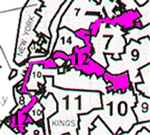| New York’s Political Lineup
Greater New York City Area |
Legal Issues The redistricting plan for the New York state Assembly was challenged both in federal and state court. The federal suit attacked the plan on several grounds: equal population, minority vote dilution, partisan gerrymandering, and on Equal Protection grounds for fragmenting communities of interest and political subdivisions. A federal district court dismissed all claims and upheld the plan. It noted that the plaintiffs failed to make a preliminary showing of partisan gerrymandering and the equal population violations. The maximum population deviation between districts did not exceed the threshold level of 10% and the Republicans were in control of the New York senate.
The New York Court of Appeals overturned a lower court's ruling that had upheld a challenge against the state senate plan that alleged a violation of Article III of the New York State Constitution; Article III requires that no county be divided in formation of senate districts. The court explained that although the plan violated 23 counties, defendants convinced the court the breaches were made to comply with federal statutory requirements.
A state court enacted New York’s congressional plan when several plaintiffs filed suit after the New York State Assembly failed to enact a plan in 1992. A federal court also drew a plan in case the state's plan failed to be precleared by the Department of Justice in time for the state primary election. The state court plan was precleared in time for the primaries, but the plaintiffs urged the federal court to adopt its plan instead, because it was considered more amiable to minority voters. The federal court declined. The state court plan was then challenged in 1996 when some voters residing in the 12th congressional district claimed that the district was an unconstitutional gerrymander. The court concluded that the district was not narrowly tailored to comply with sections 2 or 5 of the Voting Rights Act, and was drawn with race as the predominant factor. The state was ordered to enact a new districting plan, which it did in 1997. | Who’s in Charge of Redistricting? The legislature. Since the 1980’s, a Joint Legislative Task Force on Demographic Research and Reapportionment has had responsibility for drawing congressional and state legislative districts. The senate majority leader and speaker of the house must each appoint one legislator and one private citizen and the minority leaders of both houses must appoint one member of the legislature to form a six-member body. The legislators appointed by the house and senate leaders serve as co-chairs on the task force. The governor has veto power over both plans. Redistricting Deadline Before the 2002 election cycle. Political Landscape New York State’s population has stayed relatively constant in recent decades, which has resulted in a steady decline in its number of U.S. House seats. In 2001, the state lost two more seats, resulting in a delegation of 29 seats. At a congressional level, expect partisan jockeying over which incumbents may lose seats and whether more Democratic voters might be added to Republican-held districts that are growing increasingly Democratic – Bill Clinton defeated Bob Dole in every congressional district in the state in 1996. Congressional districting in New York City – already a testament to creative cartography -- may grow contentious due to efforts to represent its increasing racial and ethnic diversity.
At a state level, the Republicans have safely controlled the state senate and the Democrats the state house for three decades, in large part due to their respective control of redistricting in their chamber. Democrats took a run at the state senate in 2000, but had an uphill battle – few incumbents ever lose in New York, largely due to their safe districts. Democrats surely will be trying to create an opportunity to sweep control of state government in 2002. | ||||||||||||||||||||||||
Districting Principles
+ = required - = prohibited | Public Access During the 1990s round of redistricting, there were two sets of public hearings around the state. Citizens were able to testify and submit proposed plans. Public hearings for this round have not been announced, but are expected. Plans to put information on the Internet are being considered. Officials will provide floppy discs containing census population and geography information that will be used by the state legislature. The New York State Legislative Task Force on Demographic Research and Reapportionment has a webpage that includes redistricting data and maps. |
Irregularly Shaped District | Irregularly Shaped District | Irregularly Shaped District |
|
|
|
· Eastern Nassau County
| · Northeast Queens; northern Nassau and Suffolk | · West Side Manhattan; parts of southwest Brooklyn |
Irregularly Shaped District | Irregularly Shaped District | Irregularly Shaped District |
|
|
|
· Parts of Brooklyn and Queens | · Lower East Side Manhattan; Brooklyn, Queens (parts) | · North Bronx, parts of Westchester County |
Irregularly Shaped District |
|
· Parts of Westchester, Bronx and Queen Counties |
Contact Information Debra Levine Lewis Hoppe |







